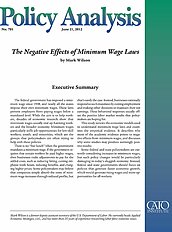The federal government has imposed a minimum wage since 1938, and nearly all the states impose their own minimum wages. These laws prevent employers from paying wages below a mandated level. While the aim is to help workers, decades of economic research show that minimum wages usually end up harming workers and the broader economy. Minimum wages particularly stifle job opportunities for low-skill workers, youth, and minorities, which are the groups that policymakers are often trying to help with these policies.
There is no “free lunch” when the government mandates a minimum wage. If the government requires that certain workers be paid higher wages, then businesses make adjustments to pay for the added costs, such as reducing hiring, cutting employee work hours, reducing benefits, and charging higher prices. Some policymakers may believe that companies simply absorb the costs of minimum wage increases through reduced profits, but that’s rarely the case. Instead, businesses rationally respond to such mandates by cutting employment and making other decisions to maintain their net earnings. These behavioral responses usually offset the positive labor market results that policymakers are hoping for.
This study reviews the economic models used to understand minimum wage laws and examines the empirical evidence. It describes why most of the academic evidence points to negative effects from minimum wages, and discusses why some studies may produce seemingly positive results.
Some federal and state policymakers are currently considering increases in minimum wages, but such policy changes would be particularly damaging in today’s sluggish economy. Instead, federal and state governments should focus on policies that generate faster economic growth, which would generate rising wages and more opportunities for all workers.
About the Author

This work is licensed under a Creative Commons Attribution-NonCommercial-ShareAlike 4.0 International License.
